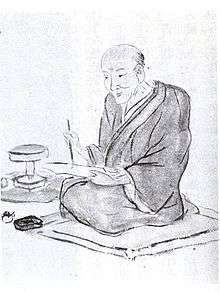Ōtagaki Rengetsu

Ōtagaki Rengetsu (太田垣 蓮月, 10 February 1791 – 10 December 1875) was a Buddhist nun who is widely regarded to have been one of the greatest Japanese poets of the 19th century. She was also a skilled potter and painter and expert calligrapher.
Biography

She was the daughter of a courtesan and a nobleman. Born into a samurai family with the surname Tōdō, she was adopted at a young age by the Ōtagaki family. She was a lady in waiting at Kameoka Castle from age 7 to 16, when she was married. She was married twice and had five children.
However, her husband died in 1823. She became a Buddhist nun at the age of thirty after burying both husbands, all of her children, her stepmother and stepbrother. Her adoptive father joined her. Ōtagaki joined the temple Chion-in and became a nun, taking Rengetsu ("Lotus Moon") as her Buddhist name. She remained at Chion-in for nearly ten years, and lived in a number of other temples for the following three decades, until 1865, when she settled at the Jinkō-in where she lived out the rest of her life.
Being a woman, she was only allowed to live in a Buddhist monastery for a couple of years. After that she lived in tiny huts and moved around quite a lot. She was a master of martial arts having been trained since childhood by her adoptive family. The Otagaki family were well known as teachers of ninja.

Though best known as a waka poet, Rengetsu was also accomplished at dance, sewing, some of the martial arts, and Japanese tea ceremony. She admired and studied under a number of great poets including Ozawa Roan and Ueda Akinari, and later in her life became a close friend and mentor to the artist Tomioka Tessai. A number of Tessai's works, though painted by him, feature calligraphy by Rengetsu.
Her ceramic work became so popular it was continued after her death as Rengetsu ware.[1]
References
- Takeuchi, Melinda (1985). "Ōtagaki Rengetsu." Kodansha Encyclopedia of Japan. Tokyo: Kodansha Ltd.
Further reading
- Ōtagaki Rengetsu. (translated by John Stevens) (2014). Rengetsu: Life and Poetry of Lotus Moon. Echo Point Books & Media. p. 182. ISBN 1-6265-4931-1.
- Melanie Eastburn, Lucie Folan, Robyn Maxwell. Black Robe, White Mist: Art of the Japanese Buddhist Nun Rengetsu. National Gallery of Australia. 2008. 148 pages. ISBN 978-0642541390
- John Walker, Kazuya Oyama. Otagaki Rengetsu: Poetry & Artwork from a Rustic Hut. 208 pages. Amembo Press. 2014. ISBN 978-4905333036
External links
![]() Media related to Ōtagaki Rengetsu at Wikimedia Commons
Media related to Ōtagaki Rengetsu at Wikimedia Commons